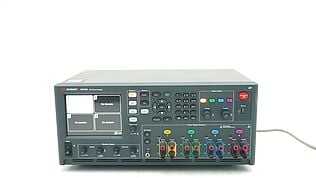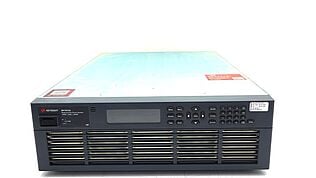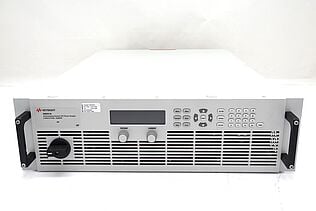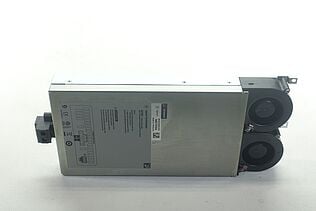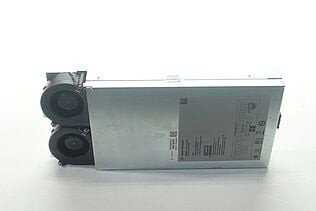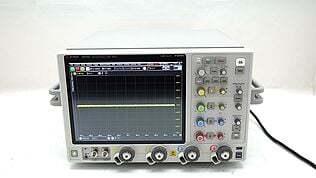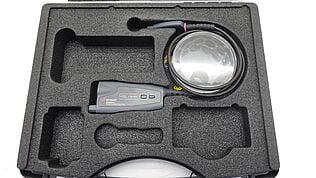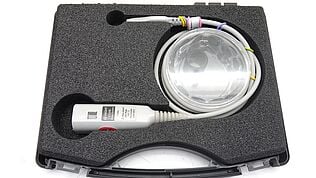- Introduction
- What is a Bench Power Supply?
- Types of Bench Power Supplies
- Linear Power Supplies
- Switching Power Supplies
- Ready to Equip Your Lab? Explore Our Range of Bench Power Supplies
- Core Features to Consider When Choosing a Bench Power Supply
- Voltage and Current Ratings
- Power Stability and Noise
- Connectivity and Interfaces
- Output Channels
- Form Factor and Size
- Programmability and Software
- Calibration and Standards Compliance
- Advanced Features and Their Impact
- Enhanced Measurement Capabilities
- Safety and Protection Features
- Practical Selection Criteria: Beyond the Specs
- Real-World Applications
- Selecting the Right Supplier
- Balancing Budget and Performance
- New vs. Used: What's Best for You?
- Shop Premium Used and Refurbished Options
- Conclusion: Power Your Projects with Confidence
- Whenever You’re Ready, Here Are 5 Ways We Can Help You
Imagine a scenario in a high-tech lab where a group of engineers are huddled around a prototype. After months of development, they're ready for the final test. One of the keys to this critical moment? A bench power supply, ensuring the right amount of power flows into their creation.
It's not just a tool; it's the lifeline of their project, providing the precise power necessary to breathe life into their innovative design.
In such scenarios, across countless labs and workshops, the bench power supply stands as an unsung hero, pivotal in transforming ideas into reality.
What is a Bench Power Supply?
A bench power supply is a specialized electrical power supply designed for use in a variety of settings, including laboratories, workshops, and educational environments. It differs from other power sources due to its precision, adaptability, and benchtop design. Unlike standard power supplies that offer fixed voltage and current, bench power supplies provide much greater control over these parameters. Here are some of its defining features:
- Adjustable voltage and current: This is the cornerstone of a bench power supply. Users can fine-tune the voltage and current to specific levels, accommodating a wide range of electrical requirements. This flexibility is crucial for experiments and tests that demand precise electrical inputs.
- Multiple outputs: Many bench power supplies come with several outputs, allowing users to power multiple devices or experiments simultaneously. This feature is especially useful in settings where space and resources are limited, as it reduces the need for multiple separate power supplies.
- Display screens: These screens provide real-time monitoring of the output parameters, such as voltage and current. This instant feedback is essential for maintaining control over experiments and ensuring that the power supply meets the required specifications.
Overall, a bench power supply is an indispensable tool for anyone involved in electrical engineering, research, or education, providing a level of control and versatility that standard power sources cannot match.
Types of Bench Power Supplies
Bench power supplies come in various forms, each with its unique features and applications. The two primary types are linear and switching power supplies.
Linear Power Supplies
Linear power supplies regulate the output voltage or current by dissipating excess power in the form of heat through a series of transistors. They are known for their simple design and smooth power delivery.
Pros
- Low electrical noise: They generate very little electrical noise, making them ideal for sensitive audio, video, and analog circuit testing.
- Stable output: Linear supplies provide highly stable and clean power, crucial for precision applications.
Cons
- Inefficiency: They are less energy-efficient, as a significant amount of power is lost as heat.
- Size and weight: Due to the heat dissipation components, they tend to be larger and heavier.
Switching Power Supplies
Switching power supplies use a more complex method of cutting the input power into high-frequency pulses and then smoothing these out to the desired output level. This method is more efficient in terms of energy conversion.
Pros
- Efficiency: They are more energy-efficient, converting a higher percentage of input power into output power.
- Compact and lightweight: These supplies are generally smaller and lighter than linear types due to their efficient design.
Cons
- Electrical noise: They can generate more electrical noise, which might interfere with sensitive electronics.
- Complexity: Their design is more complex, which can impact repair and maintenance.
When choosing a bench power supply, consider the application. For sensitive audio or analog work, a linear supply might be preferable for its clean power output. In contrast, for applications where efficiency and size are priorities, a switching power supply could be more suitable. The key is to match the power supply's characteristics with the specific requirements of the task at hand.
Ready to Equip Your Lab? Explore Our Range of Bench Power Supplies
Core Features to Consider When Choosing a Bench Power Supply
Selecting the right benchtop power supply is a critical decision for any engineer or technician. It’s not just about picking a power source; it’s about ensuring that the chosen supply aligns perfectly with the specific needs of your projects and devices. Understanding the key features and specifications is essential in making an informed choice.
Voltage and Current Ratings
The voltage and current ratings of a bench power supply are perhaps its most crucial aspects. These ratings determine the range of devices and experiments the supply can support.
It's vital to understand the power requirements of the devices you're working with. The supply you choose must be able to provide the necessary voltage and current without overloading or underpowering the device.
- Voltage range: This indicates the maximum and minimum voltages the power supply can deliver. Ensure that the supply's voltage range encompasses the requirements of your device. If your device needs a specific voltage to operate correctly, the power supply must be able to provide that voltage steadily.
- Current range: The current range shows the maximum current the power supply can offer. It's important to know the current demands of your device. A power supply with a current rating that's too low won't be able to drive the device efficiently, while an excessively high rating might pose a risk of damage. One of the most useful features of a bench power supply is constant voltage and constant current mode.
When reading specifications, look for the 'maximum' or 'peak' ratings for voltage and current. These figures tell you the highest levels the supply can handle. It's also beneficial to consider any adjustable ranges for these ratings, as this gives you flexibility in testing different devices with varying power requirements.
Matching these ratings accurately with your devices ensures not only the effectiveness of your experiments and tests but also the safety and longevity of both the power supply and the devices connected to it. Understanding how to measure current accurately with a multimeter is also crucial when working with bench power supplies.
Power Stability and Noise
In sensitive electronic testing and applications, the power stability and noise levels of a bench power supply play a critical role. These factors can significantly influence the accuracy and reliability of test results, especially in precision electronic applications.
Significance of Power Stability
Power stability refers to the ability of the power supply to maintain a consistent output voltage and current under varying load conditions.
This stability is paramount in applications where even minor fluctuations can lead to significant errors or malfunctions in sensitive electronic components. For instance, in microelectronic circuits or precision analog measurements, stable power ensures accurate and repeatable results.
Importance of Low Noise
The term 'noise' in the context of power supplies usually refers to the unwanted fluctuations or ripple in the output voltage. High levels of noise can introduce errors in sensitive measurements or cause interference in signal processing circuits.
In applications like audio electronics, medical equipment, or high-precision measuring instruments, minimizing this electrical noise is critical for maintaining the integrity of the data or signals being processed.
Specifications to Look For
To ensure stability and noise reduction, consider the following specifications:
- Load and line regulation: These specifications indicate how much the output voltage or current changes with varying load conditions and input line voltages. Lower percentages in these specifications signify better stability.
- Ripple and noise levels: Usually expressed in millivolts peak-to-peak (mVpp) or decibels (dB), these figures give you an idea of the amount of electrical noise present in the power supply's output. Lower values mean less noise and cleaner power.
- Transient response time: This indicates how quickly the power supply can respond to changes in load, which impacts stability. Faster response times are generally better.
When choosing a bench power supply, closely examine these specifications, especially if you are working with highly sensitive or precision devices. A power supply that maintains a stable output and minimizes electrical noise can be the difference between successful and flawed experiments or tests.
Connectivity and Interfaces
In the modern era of interconnected and automated test environments, the connectivity options of a bench power supply are as important as its electrical characteristics.
A variety of interfaces, such as USB, Ethernet, or GPIB (General Purpose Interface Bus), can significantly expand the functionality and integration capabilities of the power supply.
Understanding these options and choosing the right one can greatly affect the ease of integration and operation in your specific setting.
USB Connectivity
- Usage: USB (Universal Serial Bus) is widely used for connecting a power supply to a computer for control and monitoring. It's ideal for desktop applications where the power supply needs to be controlled by software or for data logging purposes.
- Benefits: USB is almost universally available on modern computers and offers a simple plug-and-play solution, making it a convenient option for most users.
Ethernet Connectivity
- Usage: Ethernet connectivity allows the power supply to be integrated into a network, enabling remote control and monitoring. This is particularly useful in large labs or industrial settings where centralized control and automation are required.
- Benefits: It supports longer distances than USB and enables multiple devices to be controlled from a single point, enhancing the efficiency of large-scale operations.
GPIB Interface
- Usage: The GPIB interface is a traditional standard for instrument control. It's often used in complex test systems where multiple devices, including power supplies, need to communicate with each other.
- Benefits: GPIB is known for its durability and reliability in industrial and research environments, though it requires specialized cables and connectors.
Choosing the Right Connectivity
The choice of connectivity should be guided by the existing systems and the intended use of the power supply. For simple, single-device control, USB might be sufficient. However, for integration into a larger network or automated test system, Ethernet or GPIB may be more appropriate.
Consider not only the current requirements but also potential future expansions of your setup. The right connectivity option can streamline workflows, enhance data management, and improve overall efficiency in your electronic testing or research environment.
Output Channels
One of the key differentiators in bench power supplies is the number of output channels they offer. The choice between single and multiple output channels can have a significant impact on the flexibility and capability of the power supply, depending on the nature of your projects.
Single Output Channels
- Characteristics: A single output channel power supply provides one set of voltage and current outputs. It's simpler and usually more straightforward to use.
- Benefits: It's ideal for applications where only one voltage or current setting is needed at a time. The simplicity often translates to cost-effectiveness and ease of use, making it suitable for basic tasks or where budget constraints are a consideration.
Multiple Output Channels
- Characteristics: Power supplies with multiple output channels can provide different voltages and currents simultaneously through separate channels.
- Benefits: This type of supply is invaluable in more complex projects where different parts of the circuit or multiple devices need to be powered independently under different conditions. It saves space and costs by reducing the need for multiple single-channel power supplies.
Assessing the Number of Channels Needed
When deciding on the number of channels you need, consider the complexity and requirements of your work.
If your projects typically involve testing or powering single devices at a time, a single-channel power supply might suffice. However, if you often work on projects that require simultaneous testing of multiple components with varying power needs, a multi-channel power supply will be more efficient and convenient.
It's also wise to think about future projects. If there's a possibility that your needs might evolve to more complex setups, opting for a multi-channel power supply could be a prudent investment, offering more versatility as your work grows in complexity.
Form Factor and Size
The physical size and form factor of a bench power supply are crucial considerations, particularly in workspaces where space is at a premium. The dimensions and design of a power supply can greatly influence how it fits into your work environment and how conveniently it can be used.
Importance of Size and Form Factor
- Workspace Compatibility: In a crowded lab or a compact workspace, a bulky power supply can be cumbersome. It's important to choose a model that fits comfortably in the available space without hindering access to other equipment or the workspace itself.
- Portability: If your work involves moving the power supply between different locations, a compact and lightweight design becomes even more important. Smaller, more portable models are easier to transport and set up in new environments.
Balancing Power Needs with Space Constraints
Finding the right balance between the power requirements of your projects and the physical constraints of your workspace is key.
- Assess your power needs: Determine the maximum voltage and current requirements for your typical applications. This will guide you in selecting a power supply that doesn’t exceed your practical needs in terms of capacity.
- Evaluate workspace layout: Take stock of your available space, considering not only the benchtop area but also the ease of access to the power supply’s controls and connections.
- Look for compact designs: Many modern power supplies come in slim, compact designs that pack a good amount of power into a small footprint. These can be ideal for space-constrained environments.
- Consider mounting options: Some power supplies are designed to be rack-mounted, which can be a space-saving solution in certain setups.
By carefully considering these factors, you can select a bench power supply that delivers the necessary power performance while fitting seamlessly into your workspace, ensuring both efficiency and convenience in your daily tasks.
Programmability and Software
Programmability in bench power supplies has become a significant feature, particularly with the rise of automated testing and intricate experiment setups. The integration of software control in power supplies offers enhanced precision, repeatability, and efficiency in a variety of applications.
Advantages of Programmability
- Automated testing: Programmable power supplies allow for automated test sequences, where voltage and current levels can be changed according to a predefined schedule without manual intervention. This is especially useful in long-term reliability tests or when dealing with large batches of tests that require consistency.
- Repeatability: Once a test sequence is programmed, it can be repeated with exact precision. This ensures consistency in test conditions, which is crucial for accurate comparison of results over time or across different samples.
- Complex experiment setup: Programmable power supplies can be set to respond to certain conditions or to simulate specific power scenarios. This flexibility is invaluable in research and development settings where complex, dynamic power requirements are the norm.
Software Compatibility and Control
The benefits of programmability are maximized when the power supply is compatible with commonly used software platforms or comes with intuitive, user-friendly software.
- Software compatibility: Check if the power supply is compatible with standard software tools used in your work environment. Compatibility with popular programming languages or platforms (like LabVIEW or MATLAB) can greatly facilitate integration into existing systems.
- Ease of control: The software provided with the power supply should offer an intuitive interface for programming and monitoring. It should allow for easy setting of parameters, scheduling of sequences, and real-time monitoring of output.
When selecting a bench power supply, assess the sophistication of your testing needs and the role of automation in your work.
A power supply with robust programmability and compatible software can be a game-changer, significantly boosting productivity and the capability to conduct advanced and precise testing procedures.
Calibration and Standards Compliance
Calibration and adherence to international standards are critical aspects of bench power supplies, especially in industries where precision and reliability are paramount.
Understanding the role of these factors can help ensure that your power supply consistently delivers accurate and reliable performance.
The Role of Calibration
Calibration involves adjusting the power supply to ensure that its output accurately matches the stated specifications. It is essential for maintaining the precision of the device over time.
- Frequency of calibration: The frequency of calibration depends on how intensively the power supply is used and the specific requirements of your work. For standard use, annual calibration is often sufficient. However, in high-precision environments or under heavy usage, more frequent calibration may be necessary.
- Calibration process: Calibration should be performed using standard reference equipment that has traceability to international standards. This ensures that the calibration is accurate and reliable.
Choosing the right calibration company is as important as selecting the power supply itself; here's a guide on how to evaluate calibration companies effectively.
Importance of Standards Compliance
Meeting international standards like ISO (International Organization for Standardization) or NIST (National Institute of Standards and Technology) is crucial in certain industries.
- Quality assurance: Compliance with these standards is often required in industries like aerospace, automotive, and healthcare. It ensures that the equipment meets the rigorous quality and performance criteria necessary for these fields.
- Global compatibility: Adhering to international standards allows for compatibility and interoperability of equipment in global markets. This is important for companies that operate internationally or supply products to global clients.
- Regulatory requirements: In some industries, meeting specific standards is a regulatory requirement. Non-compliance can lead to legal issues and loss of market access.
When choosing a bench power supply, consider the calibration needs and standards compliance relevant to your industry. For high-accuracy applications or in regulated industries, selecting a power supply that is easily calibrated and complies with international standards is crucial for ensuring both performance and regulatory adherence.
Advanced Features and Their Impact
When delving into the world of bench power supplies, the presence of advanced features can significantly enhance the functionality and usability of these devices.
For professionals working on complex projects or in demanding environments, these advanced capabilities are not just conveniences but necessities.
They can transform a standard power supply into a powerful tool for precision measurement, analysis, and safety management.
Enhanced Measurement Capabilities
Modern bench power supplies often come equipped with sophisticated measurement and analysis functions that go beyond basic voltage and current adjustments. These enhanced features support complex projects where precision and detailed data analysis are critical.
- Traceable measurements: Allows for tracking and recording of output data over time, essential for long-term testing and quality assurance processes.
- Integrated data logging: Provides the ability to log output parameters, useful for trend analysis and performance monitoring.
- Programmable sequences: Enables the setting of specific output patterns or sequences, vital for testing under varying conditions or simulating real-world scenarios.
- Real-time analysis functions: Offers tools for immediate analysis of power supply performance, facilitating quick adjustments and decision-making.
Safety and Protection Features
The safety features integrated into a bench power supply are crucial for protecting both the equipment and the user. These features prevent damage to the power supply and the devices connected to it, ensuring safe operation under various conditions.
| Safety Feature | Importance |
|---|---|
| Overcurrent Protection | Prevents damage to the power supply and the connected device by cutting off power when current exceeds a safe level. |
| Overvoltage Protection | Protects sensitive devices from receiving voltage higher than they can handle, thereby preventing potential damage. |
| Thermal Shutdown | Automatically shuts down the power supply if it overheats, reducing the risk of fire or damage to internal components. |
| Short-Circuit Protection | Immediately cuts power in the event of a short circuit, safeguarding the power supply and connected equipment. |
| Reverse Polarity Protection | Prevents damage if connections are made with reversed polarity, ensuring operational safety. |
These advanced measurement and safety features greatly enhance the utility and reliability of bench power supplies, making them indispensable tools for a wide range of high-precision and safety-critical applications.
Practical Selection Criteria: Beyond the Specs
Choosing the right bench power supply involves more than just matching specifications to needs; it requires a thoughtful consideration of how the supply will be used in real-world applications.
Understanding the practical aspects of how certain features benefit specific scenarios can guide you in selecting a power supply that not only meets but enhances the efficiency and effectiveness of your projects and experiments.
Real-World Applications
In the diverse landscape of electronics, each project or experiment comes with its unique demands. Here are some real-world scenarios where specific features of power supplies can be particularly advantageous.
Research and Development Labs
- Feature: Enhanced measurement capabilities
- Benefit: In R&D, precision is key. Features like traceable measurements and integrated data logging enable accurate tracking and analysis of experimental data, crucial for developing new technologies or refining existing ones.
Educational Settings
- Feature: User-friendly interfaces and controls
- Benefit: For educational purposes, a power supply that is easy to use and understand is vital. It allows students to focus more on learning principles rather than struggling with complex equipment.
Production Line Testing
- Feature: Programmability and automated sequences
- Benefit: In production testing, speed and consistency are essential. Programmable sequences allow for rapid and consistent testing of products, enhancing efficiency and quality control.
Quality Assurance in Manufacturing
- Feature: High accuracy and stability
- Benefit: For QA processes, the accuracy and stability of a power supply ensure that products meet stringent quality standards, reducing the risk of defects or failures.
Service and Repair Shops
- Feature: Multiple output channels
- Benefit: In repair shops, technicians often work on several devices simultaneously. Multiple outputs allow for efficient use of space and resources, improving workflow.
Aerospace and Automotive Industries
- Feature: Safety and protection features
- Benefit: The high-stakes nature of these industries demands a power supply with robust safety features like overcurrent and thermal shutdown to prevent damage to sensitive and expensive components.
Audio and Video Equipment Testing
- Feature: Low electrical noise
- Benefit: In testing audio and video equipment, minimizing electrical noise is crucial to avoid interference and ensure high-fidelity results.
Telecommunications Equipment
- Feature: High power output
- Benefit: For testing and powering telecommunications equipment, a power supply with a high power output is necessary to handle the demanding energy requirements of these devices.
Remote Testing Sites
- Feature: Portability and compact design
- Benefit: For field engineers who need to conduct tests in remote locations, a compact and portable power supply is essential for easy transportation and setup.
Biomedical Research
- Feature: Precision and programmable limits
- Benefit: The sensitivity of biomedical research requires a power supply that can precisely control power outputs and has programmable limits to protect delicate samples or equipment.
In each of these scenarios, the right bench power supply can significantly impact the results and efficiency.
By considering the practical application of the power supply’s features in real-world settings, you can make a more informed choice that aligns with the specific needs and challenges of your projects or experiments.
This approach ensures that the equipment you select not only meets your current requirements but also adapts to future demands, thereby maximizing the investment in your power supply solution.
Selecting the Right Supplier
Choosing a bench power supply isn’t just about the product itself; it's equally about selecting the right supplier. The quality of service and support you receive can be just as critical as the specifications of the power supply.
A reputable supplier not only offers quality products but also provides comprehensive support that includes warranty, technical assistance, and reliable post-purchase services.
Importance of a Reputable Supplier
- Warranty: A strong warranty is a sign of a supplier's confidence in their product. It ensures that you are covered in case of defects or issues, providing peace of mind and protection for your investment.
- Technical support: Good technical support can be invaluable, especially when dealing with sophisticated equipment like bench power supplies. Access to expert advice and troubleshooting can save time and resources, particularly in critical or complex situations.
- Post-purchase services: This includes services like calibration, repair, and regular maintenance. Reliable post-purchase services ensure that your power supply continues to perform at its best over its lifespan.
The Value of Keysight
Companies like Keysight are renowned for their commitment to quality and customer support. They stand out by offering:
- High-quality products: Keysight is known for its high standards in manufacturing and quality control, ensuring that their power supplies are reliable and durable.
- Comprehensive warranty: They typically offer robust warranties, reflecting their trust in the quality of their products.
- Exceptional technical support: Keysight provides excellent technical support, with access to experts who can assist with product selection, troubleshooting, and usage tips.
- Calibration and maintenance services: Their post-purchase services, including regular calibration and maintenance, help in maintaining the accuracy and longevity of the power supplies.
Selecting a supplier like Keysight means investing in a relationship that extends beyond the initial purchase. Their focus on quality, combined with comprehensive support and services, adds significant value to your investment.
This approach not only ensures that you get a product that meets your current needs but also provides ongoing support that helps you keep pace with evolving demands and technologies.
Balancing Budget and Performance
When selecting a bench power supply, balancing budget constraints with performance requirements is a critical exercise.
Evaluate the power supply's performance to meet your needs and understand how it can affect your projects and experiments.
Consider alternative options like premium used or refurbished units and factor in the total cost of ownership to offer financial advantages without compromising quality.
Evaluating Performance for Specific Tasks
- Understand task requirements: Begin by clearly defining the power requirements of your projects. Consider factors like voltage and current needs, stability, noise levels, and the necessity for programmable features.
- Match specifications to needs: Select a power supply whose specifications align closely with these requirements. Over-specifying can lead to unnecessary costs, while under-specifying might compromise the results or safety of your experiments.
Impact of Performance on Results
- Precision and accuracy: The performance of a power supply directly affects the precision and accuracy of your testing. Inaccuracies can lead to flawed experiments or the development of unreliable products.
- Efficiency: High-performance power supplies can enhance the efficiency of your work, allowing for faster and more reliable testing, which is crucial in fast-paced or high-throughput environments.
Financial Advantages of Used or Refurbished Units
- Cost-effective: Premium used or refurbished power supplies can provide significant cost savings compared to new units. These options are particularly beneficial for budget-conscious settings without compromising on quality.
- Reliability: If sourced from reputable suppliers, these units often come with warranties and have been rigorously tested to meet original performance standards.
Total Cost of Ownership
- Maintenance and calibration: Consider the long-term costs associated with maintaining and calibrating the power supply. A cheaper unit might require more frequent calibration or might have higher maintenance costs.
- Durability and lifespan: A higher initial investment in a quality power supply can lead to lower costs over time due to longer lifespan and reduced need for repairs.
Balancing budget and performance involves a thorough evaluation of both immediate needs and long-term considerations. Opting for a power supply that meets your specific performance requirements can lead to better outcomes in your projects.
At the same time, exploring options like premium used or refurbished units can be a smart financial decision, provided they meet the necessary quality and reliability standards.
Always consider the total cost of ownership, including maintenance and calibration intervals, to ensure that your investment remains cost-effective over the long term.
New vs. Used: What's Best for You?
When buying bench power supplies, an important decision is whether to choose new or used/refurbished equipment.
Each option has its pros and cons, and understanding these can help you make an informed decision that best suits your needs.
Here's a detailed comparison, along with insights into how Keysight ensures the quality of used equipment and the additional benefits of opting for a used or refurbished unit.
| Factor | New Bench Power Supply | Used/Refurbished Bench Power Supply |
|---|---|---|
| Cost | Higher initial investment | Lower initial cost |
| Warranty and Support | Full Keysight warranty and support | Same as new |
| Technology | Latest models with advanced features | Older models may not have recent technology or features |
| Reliability | High, as the product is brand-new | Works like new after comprehensive refurbishment process |
| Availability | Readily available | Dependent on market availability |
| Environmental Impact | Higher due to manufacturing new products | Lower, as it extends the life of existing equipment |
Keysight’s Quality Assurance for Used Equipment
Keysight is known for maintaining high-quality standards, even for their used or refurbished equipment. They ensure that every piece of equipment, from power supplies, to oscilloscopes, signal generators and spectrum analyzers undergo rigorous testing and calibration to meet original factory specifications. This process includes:
- Comprehensive testing: Each unit is thoroughly tested to ensure it performs as expected.
- Calibration: Equipment is recalibrated to factory standards, ensuring accuracy and reliability.
- Quality control: Keysight adheres to strict quality control procedures during the refurbishment process, ensuring that the used equipment is as reliable as a new one.
Value Retention in Premium Power Supplies
High-quality, well-maintained bench power supplies, especially from reputable brands, tend to retain their value over time. This makes them a wise investment, as they can provide reliable service for many years and still maintain a significant portion of their initial value if resold.
Environmental Benefits
Opting for used or refurbished equipment also has notable environmental benefits. It reduces e-waste and the demand for new raw materials, contributing to a more sustainable approach to equipment usage. By extending the life of existing power supplies, you're participating in a form of recycling that benefits the environment.
The decision between new and used or refurbished bench power supplies depends on various factors, including budget constraints, your technology needs, reliability concerns, and environmental considerations.
Keysight provides an excellent option for individuals considering used equipment. Buying used or refurbished not only impacts your immediate work requirements but also has broader implications in terms of investment value and environmental sustainability.
Shop Premium Used and Refurbished Options
Select up to 3 instruments to compare
Enable Notifications
In order to use this feature, you need to enable notifications.
Manage notification preferences
Conclusion: Power Your Projects with Confidence
In this comprehensive guide, we’ve navigated the critical aspects of selecting the ideal bench power supply, emphasizing its pivotal role in a variety of professional settings.
From understanding different types of power supply units to considering core features such as voltage and current ratings, power stability, and noise levels, each element plays a significant role in tailoring your choice to your specific needs.
A well-chosen bench power supply is more than just an equipment purchase; it’s an investment in the quality and success of your work. Whether you're conducting intricate research, carrying out precise testing, or engaging in educational activities, the right power supply ensures that your projects are powered with accuracy and reliability.
Selecting the bench power supply that meets the demands of innovation and precision ensures that you are not just prepared for today’s challenges but also future-proofing your workbench for upcoming discoveries. (For additional inspiration and wisdom in the field of engineering, explore these insightful engineer quotes.)
Whenever You’re Ready, Here Are 5 Ways We Can Help You
- Browse our premium used network analyzers, oscilloscopes, signal analyzers and waveform generators.
- Call tech support US: 1 800 829-4444
Press #, then 2. Hours: 7am – 5pm MT, Mon– Fri - Talk to our sales support team by clicking the icon (bottom right corner) on every offer page
- Create an account to get price alerts and access to exclusive waitlists.
- Talk to your account manager about your specific needs







